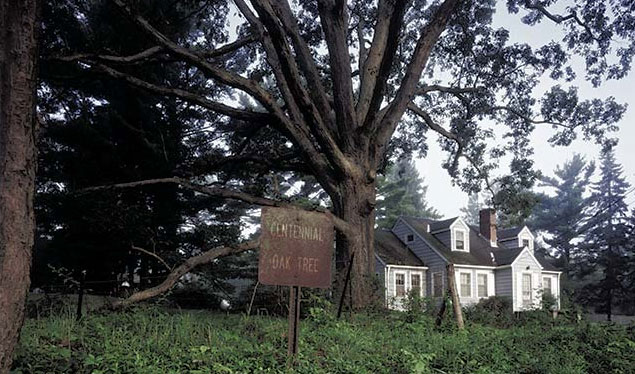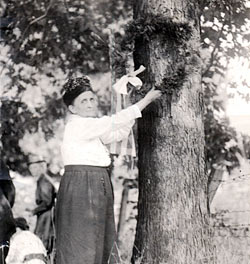

Photograph © Charles J. Mintz
Planted by the Newbury Women's Political Suffrage Club on July 4, 1876, the tree, just like the suffrage movement, survived and grew larger and stronger. It was a symbolic move, planting the roots of a movement that would go on to change America's face forever.
History of Union Chapel / Centennial Oak


Photos courtesy Beverly Ash
Residents of South Newbury built the Union Chapel in 1858 on land donated by Anson Mathews. It was dedicated to free speech by 26-year-old teacher James A. Garfield, future 20th President of the United States, after the Congregationalists of the nearby Brick Church denied him the right to speak in their building because “the church should be used for the Word of God alone.” Union Chapel was used as a community center allowing, according to its deed, “to be used for literary, scientific, moral and religious purposes for lectures upon all useful subjects, open and free for all denominations, but to be monopolized by no one or more to the exclusion of any one.”
One of the oldest woman’s suffrage groups in the United States, The South Newbury Women’s Suffrage Political Club, was organized at the chapel. Often called the “Free Speech chapel” and “cradle of Equal Suffrage,” the chapel played an important role in the struggle for women’s right to vote. Susan B. Anthony gave many of her speeches on women’s suffrage there. Other notable speakers include suffragists Lucy Stone and Ellen Munn; Louisa May Alcott; Harriet Taylor Upton; advocate of the eight-hour work day, Theodore Parker; and John B. Gough, three-time presidential candidate on the Prohibition ticket.
Members of the Newbury Women’s Political Suffrage Club planted the Centennial Oak on July 4, 1876 to commemorate the 100th year of the nation’s independence. Because of the bitter antagonism against equal rights, the club decided to plant the white oak tree (Quercus alba) across the street from the chapel on private property to avoid vandalism and destruction. The tree survived and flourished as the years passed, just as the suffrage movement advanced and succeeded, becoming a symbol of the movement that would go on to change America’s face forever.
The Geauga Park District purchased the land on which Union Chapel sits from the Krehlik family in 1998, while the Centennial Oak stands on private land adjacent to the site. In January 2010, the Park District and South Newbury Union Chapel trustees formed a partnership in order to preserve the Union Chapel and to promote its historic significance. Stewards Beverly Ash, Michael Fath, and Sandra Woolf have worked since that time to raise awareness of the two sites. Under the direction of the stewards, arborists from The Davey Tree Expert Company performed dormant pruning and cabling on the Centennial Oak tree in order to support the heavy branches and performed extensive brush clearing and maintenance in the surrounding area to promote a healthier environment for the tree.
The South Newbury Union Chapel has been designated as an Ohio Historic Site by the Ohio Historical Society and, in 2010, an Ohio Historical Marker was dedicated at the site.

Photograph © Charles J. Mintz
Threat
The 16.5 acre property that surrounds the Union Chapel is not only an important historical site, it is within the Cuyahoga River watershed, home to muskrat, beaver and other wetland wildlife, as well as a population of little brown and big brown bats that reside in bat houses built by Eagle Scouts. As the stewards work to preserve the landscape’s natural and cultural resources, it is hoped that they can promote the site’s once diverse native landscape that existed during the 1800s. Without the proper support, though, these goals cannot be met.

